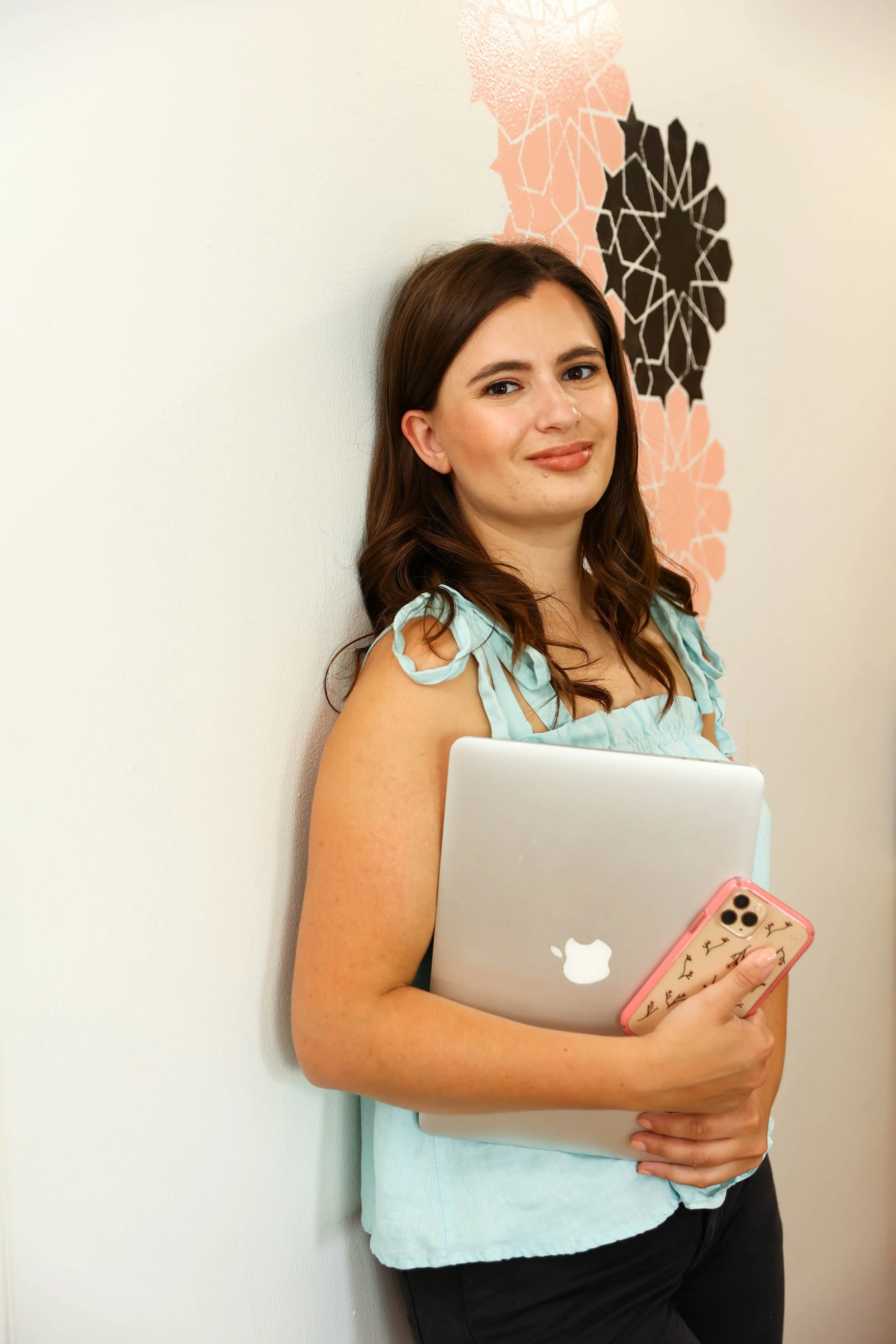How To Write an Amazing Blog Post (For Beginners!)
It’s hard to believe that I've been running Keep Calm and Chiffon, for over 10 years now.
When I started my blog, it was purely out of my love for writing and desire to have my own little slice of the internet where I could express myself creatively.
But over time, I started to take my blog more seriously and I've learned that writing to attract an audience requires a different approach than writing just for yourself.
I wish then I had found a guide to writing a blog post for beginners.
How To Write an Amazing Blog Post (For Beginners!)
Today I want to share with you my step-by-step process for writing a blog post that will not only get discovered through organic search (aka on Google), but also help you attract and retain your dream readers.
It took me years to master this process, and I’m sharing it with you so you can achieve your blog goals faster, whether that’s taking blogging full-time or reaching enough monthly sessions to qualify for a blog ad network.
Brainstorming session
Before we get into writing, I always recommend doing a big brainstorming session.
I love sitting down with a cup of coffee (or a glass of wine if I’m doing an evening session) and jotting down ideas for potential blog post topics that I think my audience would enjoy and that I would be excited to write about.
There are so many sources you can tap into for inspiration during this process.
You can ask your existing audience what they want to see from you or think about the questions they frequently ask.
Simply post a question box on your Instagram stories or send a Google Form questionnaire out to your email list and see what people respond with.
You can also look through comments, DM’s and emails that you’ve received from your audience members to guide your topic list.
Analyzing your website's Google Analytics data and identifying your top-performing posts can also generate new ideas.
Check to see what your top 10 performing blog posts from the last 6 months have been and try to think of two related ideas for each of those topics.
Additionally, free keyword tools like Google Trends, Pinterest Trends, and Answer the Public can provide insights into trending topics and specific questions people are searching for.
Type in broad topics related to what you blog about and see the most popular searches from users over the last few weeks or months.
Topic validation
Once you have what is probably a very long list of topic ideas, the next step is to validate each of these topics.
It's crucial to ensure that there is a demand for the content you plan to create and most people skip this validation step when they first start blogging.
Take some time to research and see what other bloggers or content creators are covering in a similar space.
Typing each keyword into Google and scanning through the number of search results and the types of website that are ranking for these topics will be key to understanding if you’ll have the potential to rank for the posts you’re hoping to write.
Find a keyword that aligns with what your audience is searching for and make sure it accurately represents the content of your post.
Pro tip: It's beneficial, especially for newer or smaller sites, to target keywords with monthly searches ranging from 10 to 1,000.
Ranking for smaller keywords will help build authority with Google and increase your chances of ranking for more competitive ones in the future.
Want to learn more about the importance of SEO? Check out this related blog post.
most bloggers skip topic validation, but it’s one of the most important steps to take
Create an outline
Now that you have a validated topic, it's time to outline your blog post.
Creating an outline and understanding your blog post writing format has several benefits:
First, it helps break up your content visually which is great for both your readers and for Google, since they’ll scan your blog post to quickly try to gauge what it’s about so they can recommend it to the right people.
It will also help you understand the flow of your blog post and give you a bird’s eye view of all of the components you want to include.
Each section should be informative and contribute to the overall flow of your article, so in your outlining stage be sure to ask yourself if each section is helpful and relevant to the reader.
It's important to activate header fonts (not just bolding text) in your blog because Google will read the metadata of your blog and determine those keywords as important indications of the rest of the text in those sections.
By providing subheadings as well, you give your reader and Google a clear understanding of the different sections of your blog post so anyone skimming can easily find the parts that are most important to them.
Pro tip: use bullet points or indentations to make it even easier to follow your blog post writing structure.
Introductions
Every good blog post needs an introduction, and I sometimes end up writing my introductions last so that I can sprinkle bits of what is to come in them to set the stage for my reader.
In this section, you can confirm to your readers that they're in the right place by sharing the topic and its importance.
It's also helpful to include the keyword you chose in your title within the first 100 words of your post and add in another keyword or two as these first few sentences.
This can help optimize blog posts for SEO because they can sometimes even show up in the Google search engine results page snippets.
Additionally, consider including a sentence or two about why you have the expertise or authority to write on the subject matter.
Why should someone be reading your blog post as opposed to someone else’s? What experience do you have with this topic?
As a very meta example, this blog post is all about how to write a great blog post if you’re a beginner and in the first sentence of this post I talk about how I’ve been blogging for over 10 years, confirming I have the experience to share tips and insights for beginners.
Sharing your credentials also helps to build trust with your readers, but that doesn’t need to mean having 10 years of experience to blog about something.
If you just visited Los Angeles for the first time and you want to create a blog post called “36 Hours in Los Angeles as a First-Timer” you may still be helping someone who is planning a trip and has never been and you don’t need a PhD in Los Angeles to write that post.
Post structure + length
When writing your blog post, keep your sentences clear and concise.
(I’ll be the first to admit this is hard for me to do as someone who loooooves to talk, but I can promise this is the way to go.)
Shorter sentences make it easier for readers to follow your post and stay engaged, especially if they’re reading your post on a mobile device.
Whenever possible, try to take a look at how your blog appears on different devices.
On Squarespace you can change this at the top of the screen to see how any given page will look on a desktop device, an iPad or tablet or a phone screen.
Now just because we’re going to keep our sentences short, that doesn’t mean that our post needs to be short.
Blogs are the place where you can get chatty so try to aim for a comprehensive and detailed post each time you sit down to write.
If you’re wondering how long a blog post should be for SEO purposes, plan to write at least 1,000 words or even up to 2,000 words if possible.
This will immediately give you an edge over anyone who is writing super short blog posts since you’ll have more information to share with your reader and Google will be more likely to recommend you.
Jazz up your blog post
To make your blog post visually appealing, consider adding images, graphics, and other elements to break up the text.
You can create your own graphic designs using tools like Canva.
Whenever possible, try to incorporate your own original photography into blog posts. Why?
Well with the rise of AI, Google is going to favor posts that include original photography to show your expertise and experience.
To show that you have actually done something, been somewhere or made something that you’re writing about makes a stronger case for why a reader should come to your site.
For example, someone who has never been to Los Angeles could still in theory create a list of things to do there and pull stock images to create a blog post, but as the reader wouldn’t you MUCH rather read a post by someone who has been there and experienced it for themselves?
This is where your own unique voice and experience gives you an edge, so embrace it!
Pro tip: your photos do not have to be super professional or perfect in any way. As long as they’re yours, that is the most important thing.
Another way you can jazz up blog posts is to add links to it, as you may have noticed I’ve done throughout this post.
Internal links (that link to other pages on your own website) can direct readers to related areas of your blog, keeping them on your site for longer and suggesting other posts they may like.
External links (that link to other pages on the internet not on your website) provide additional context and credibility.
For example, you may have written a blog post about the best places to eat in Los Angeles and you recently saw a news story about the best things to do in Los Angeles with kids, you may consider linkin to that to give your audience another helpful resource.
Encourage action
Finally, at the end of your blog post (or wherever it feels right to include this) consider adding a call to action of some kind for your reader.
This call to action can be a prompt to subscribe to your email newsletter, check out a related blog post, purchase a product you sell or book a 1:1 session with you.
Converting the reader from a casual user to someone who is a fan of your work is the goal, so after you provide all of that value in your blog posts, think about creative ways to incorporate your products or services into your blog post.
Graphics like banners (ehm—like the one right below this sentence) or buttons can be effective in guiding readers to take action—I often include these for my digital products into posts where I am helping other content creators achieve their goals.
Okay, wow! I know that was A LOT of information but I hope that now you feel that you have the tools to create an engaging blog post, no matter what you blog about.
If you found this helpful and you are interested in learning more about keyword research and maximizing your blog’s visibility to your ideal readers, check out my workshop What You Really Need To Know About SEO.
yours,
Austen
Photographs by Jessie Alcheh




